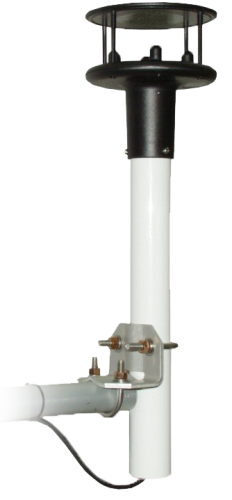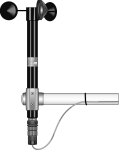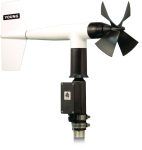






Überblick
Das Windsonic4 ist ein zweidimensionales Ultraschall-Anemometer zur Messung von Windgeschwindigkeit und -richtung. Es bietet eine alternative zu traditionellen mechanischen Windsensoren und hat keine beweglichen Teile. Es gibt ein SDI12-Signal aus, das direkt mit einem CR200(X), CR800, CR850, CR1000 oder CR3000 und auch einigen älteren Datenloggern ausgelesen werden kann.
Für Gegenden mit viel Schnee oder Eisbildung ist der Windsonic nicht geeignet, da er keine Heizung hat. Auf Anfrage können wir Ihnen gern einen beheizten Windsensor empfehlen.
Bitte beachten: Die angebotenen Halterungen können sich je nach Campbell Vertretung unterscheiden.
Lesen Sie mehrFunktionen und Vorteile
- Low maintenance—no moving parts significantly reduces maintenance cost and time
- Provides a minimum detectable wind speed of 0.01 meters per second
- Compatible with most Campbell Scientific data loggers
Bilder



Zugehörige Produkte
Technische Beschreibung
The WindSonic4 uses two pairs of orthogonally oriented transducers to sense the horizontal wind. The transducers bounce the ultrasonic signal from a hood, thus minimizing the effects of transducer shadowing and flow distortion.
Unlike mechanical anemometers, the WindSonic4 has no moving parts to be periodically replaced—minimizing routine maintenance costs.
Kompatibel mit
Mounting
The WindSonic4 is shipped with the 17387 mounting kit. This mounting kit is used to attach the sensor to a CM202, CM204, or CM206 crossarm. The crossarm is then mounted to a tripod or tower.
Data Logger Considerations
The WindSonic4 is connected to one control port, +12 Vdc, and ground. Up to ten WindSonic4s (each with a unique address) can be connected to one data logger control port.
Programming
The SDI12 instruction is used to collect data from the WindSonic4.
Spezifikationen
| Applications |
|
| Sensor | 2-dimensional ultrasonic anemometer |
| Measurement Description | Wind speed and direction |
| Operating Humidity Range | < 5% to 100% RH |
| Operating Temperature Range | -35° to +70°C |
| Storage Temperature Range | -40° to +80°C (typical) |
| Input Voltage | 9 to 30 Vdc |
| Typical Current Drain | < 10 mA (@12 V) |
| Measurement Frequency | 40 Hz block averaged to a 1 Hz output frequency |
| Outputs Parameters | Polar (direction and speed) or orthogonal (Ux and Uy wind) |
| Output Signal | SDI-12 version 1.3 |
| Diameter | 14.2 cm (5.6 in.) |
| Length | 16.0 cm (6.3 in.) |
| Weight | 0.5 kg (1.1 lb) |
Maximum Cable Length |
|
| -NOTE- | For longer cable lengths, contact Campbell Scientific. |
| 1 Sensor Connected to 1 Port | 91.44 m (300 ft) |
| 2 to 10 Sensors Connected to 1 Port | 60.91 m (200 ft) |
Wind Direction |
|
| Range | 0º to 359° (no dead band) |
| Accuracy | ±3° |
| Resolution | 1° |
Wind Speed |
|
| Range | 0 to 60 m/s |
| Accuracy | ±2% (@ 12 m/s) |
| Resolution | 0.01 m/s |
Dokumente
Broschüren Produkte
Technische Artikel
FAQs für
Number of FAQs related to WINDSONIC4: 6
Alle anzeigenWenige anzeigen
-
Yes, as long as these two conditions are met:
- There are no obstructions in the measurement volume.
- The temperature is between -35 to +70 degrees Celsius.
-
The fastest output frequency is 4 Hz for the WindSonic1 and 1 Hz for the WindSonic4.
-
There are no user-serviceable parts on the WindSonic1 and WindSonic4. Should the WindSonic require service, it will start setting diagnostic flags. Campbell Scientific recommends that all datalogger programs record the total number of times the flags are set in an output period. For details, see the WindSonic Instruction Manual.
-
All WindSonics (option 1 or option 4) are shipped from Campbell Scientific with an interface cable. If the cable has been lost, order a replacement. Order model WINDSONIC1CBL-Lxx for an option 1 or WINDSONIC4CBL-Lxx for an option 4, where xx is the cable length. The maximum cable length is 50 feet for option 1. The maximum cable on the SDI-1 bus is 200 feet.
-
The WindSonic is not suitable for measuring the vertical wind component. The WindSonic measures the wind that passes through its measurement volume. It does not care what the orientation is. If the WindSonic is turned on its side, the reflecting top and body of the sensor will cause massive flow distortion of the wind vector, specifically for the horizontal component that is perpendicular to the reflective top. This flow distortion will most likely result in erroneous vertical wind measurements.
-
The fundamental measurement frequency of the WindSonic is 40 Hz (40 measurements per second). These measurements are then averaged to give an output at some slower output frequency. For a WindSonic programmed to produce 1 Hz data, all 40 measurements are averaged. (This is called a block average.) For a WindSonic that is programmed to produce 4 Hz data, each output is the block average of 10 fundamental measurements.
Anwendungsbeispiele
Overview Iraq’s Ministry of Agriculture has deployed a nationwide network of solar-powered, satellite-linked agrometeorological stations. The......lesen Sie mehr
Tropical volcanic islands are biodiversity hotspots where the Critical Zone (CZ) remains poorly studied. In......lesen Sie mehr












